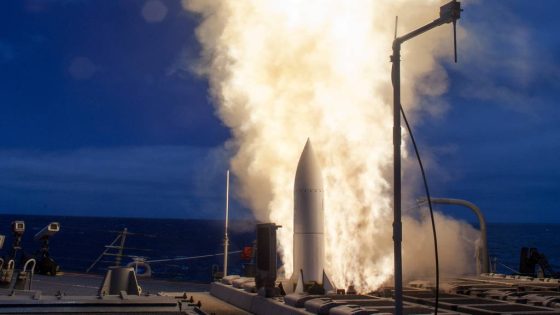A U.S. Navy Standard Missile-6, guided by the U.S. Armyâs new missile defense radar and command and control system, intercepted a target in a recent test during Valiant Shield 24 in the Indo-Pacific, Raytheon announced in a July 18 statement.
In the test involving both physical hardware and simulation, the Armyâs Lower-Tier Air and Missile Defense Sensor, or LTAMDS, simulator provided threat tracking data, along with operational SM-6 engagement control software, to the serviceâs Integrated Battle Command System, or IBCS, developed by Northrop Grumman.
The successful test is the latest reflection of the Pentagonâs desire to see the services operate seamlessly in battle.
IBCS, the brains of the Armyâs air and missile defense architecture, passed the data to initiate a launch command and guide the SM-6 to a âsuccessfulâ intercept, according to the statement.
Raytheon said the test proves that Navy missiles can work within the Armyâs integrated air and missile defense architecture.
Such a test also âconfirms a viable optionâ for U.S. Indo-Pacific Command, Tom Laliberty, company president of land and air defense systems, said.
âLTAMDS matched with SM-6 adds an exceptional capability to defeat increasingly diverse and complex threats with a multi-mission missile that flies as far as the radar can see â providing for long range Army and Joint integrated air and missile defense,â Laliberty said.
The effort to integrate the Navyâs long-range, anti-air missile that has a surface mode with Army missile defense systems could further builds out a layered missile defense architecture.
The Army is also using the SM-6 and Raytheon-built Tomahawk missiles paired with a vertical launch system for its Mid-Range Capability, or MRC, weapon rapidly developed and deployed to fit in the Armyâs fires portfolio between its Precision Strike Munition, designed to hit targets over 500 kilometers away, and its ground-launched hypersonic missiles.
The service deployed the MRC to the Philippines earlier this year as part of its annual Salaknib exercise with the island nation in April.
LTAMDS will serve as the radar in the Armyâs future Integrated Air and Missile Defense system. The Army fielded a LTAMDS battalion of four sensors in December as required by Congress, but the sensor is still in prototyping phase as the service works to integrate a back-end array to give the sensor a 360-degree tracking capability â an upgrade from the current Patriot sensorâs ability to see all the way around.
The Army plans to conduct an operational assessment in the first quarter of FY25 that will lead to an Engineering and Manufacturing Development decision in FY25, a preliminary step toward eventual serial production.
The test of the systems together is also critical in ensuring the air and missile defense architecture planned for Guam will work. The Armyâs MRC launchers, LTAMDS and IBCS will make up part of the architecture along with Aegis weapon systems equipped with SM-3 and SM-6 missiles.
Jen Judson is an award-winning journalist covering land warfare for Defense News. She has also worked for Politico and Inside Defense. She holds a Master of Science degree in journalism from Boston University and a Bachelor of Arts degree from Kenyon College.
Source Agencies



